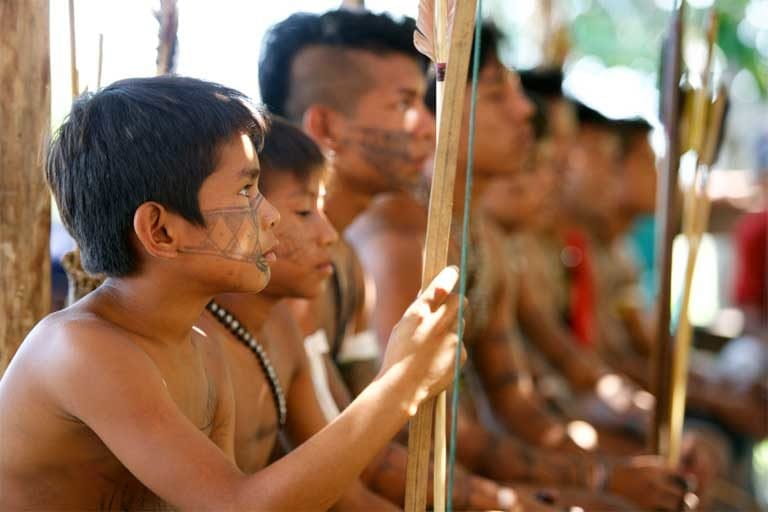- Several governments and private funders have pledged US $1.7 billion in support of Indigenous and local communities’ tenure rights in recognition of their global contributions to climate change mitigation.
- Funds will be used to support activities that will aid Indigenous and local communities to improve capacity building and secure, strengthen, and protect their land and resource rights.
- COICA, a leading Amazonian Indigenous rights organization, remains skeptical of the fund’s promise to reach Indigenous territories and support communities but says it will monitor the actualization of these new commitments.
Several governments and private funders have announced at the COP26 United Nations climate summit plan to invest US $1.7 billion to support Indigenous and local communities’ land tenure and resource rights in recognition of the role they play in climate change mitigation and protecting biodiversity.
The historic US $1.7 billion pledge is the largest public-private commitment to support Indigenous peoples and local communities. It was officially announced earlier today under the joint funders’ COP26 statement ‘Advancing Support for Indigenous Peoples’ and Local Communities’ Tenure Rights and Forest Guardianship’.
Governments from the United States, United Kingdom, Norway, Netherlands and Germany, along with 17 private funders, that include the Ford Foundation and the Christensen Fund, have committed to further recognize the global contributions of Indigenous People and local communities in protecting tropical forests, preserving vital ecosystems and guarding forests and nature.
The collective pledge of new funds will run from 2021 to 2025 and calls on all donors to significantly increase their support of its agenda directed at improving capacity building and securing IPLC land rights. In the statement, the rise in threats and violence against IPLCs is noted.
“This pledge signals our commitment to protecting the world’s tropical forests and those who live in them,” said Lord Goldsmith, Minister of State for Pacific and the Environment. “The evidence is overwhelming that Indigenous Peoples and local communities are forests’ most effective guardians, often in the face of acute danger, and so they should be at the heart of nature-based solutions to the climate emergency. By investing in tropical forest communities and expanding their communal rights, we will also tackle poverty, pollution, and pandemics.”

Getting funds to the community level
In a separate statement, the Ford Foundation highlighted recent studies on the discrepancy between IPLC land management and the amount of financial support they receive. A new WRI report released a few weeks ago underlines how IPLCs manage half of the world’s land and care for 80% of Earth’s biodiversity, while being allocated less than 1% of official designated assistance for climate change and less than 5% of official assistance for general environmental protection.
Further, only a small share of this assistance likely went to communities on the ground.
“The lion’s share of the money has been captured at higher levels, amongst international NGOs, consulting firms, technical experts, and government agencies: only 10% of total climate finance is committed to local levels,” noted the authors of a new PRISMA report.
In light of this, donors have pledged more direct and tangible support to communities with a strengthened accountability mechanism. The two specific criteria for the pledge are direct support to IPLC communities through capacity building and financial support to group activities, as well as funding to activities that strengthen and secure IPLC tenure rights in the form of mapping, registration work and land reform processes.
While speaking to Mongabay last month, Carlos Rodriguez, the CEO of Global Environment Facility (GEF), also emphasized the need to build capacity and structures within Indigenous communities to effectively manage financial resources.
The donors have committed to promoting the effective participation and inclusion of Indigenous peoples and local communities in the decision-making process for these funds as well as consulting and partnering with them on the design and implementation of the relevant programs. Specific interests include the involvement of women and girls, youth, people with disabilities and others who are marginalized in decision-making.

However, some Indigenous leaders remain skeptical of the promise that funding will reach the community level.
Tuntiak Katan Jua, the Vice Coordinator of COICA, the Coordinator on Indigenous Organizations of the Amazon basin, shared that the pledge of new funds to support the recognition of Indigenous Peoples land rights is applauded but he has certain reservations.
“We know that many of these funds are destined for traditional mechanisms, which have shown very great limitations to reach our territories and support communities in their initiatives,” said Jua, a native to the Ecuadorian Amazon and a member of the Shuar People. “One of its limitations is that governments have difficulties of presence in these territories (which prevents them from really controlling them), and implementing long-term policies that protect natural resources. To a large extent, intermediaries are the first beneficiaries of climate funds, and their high costs reduce the percentage that is actually invested in communities and territories.”
However, according to Jua, COICA has been working on a series of recommendations to address this issue as part of their Shandia Vision. The Shania vision is a financing ecosystem that aims to allow all financial mechanisms from philanthropies and donors to reach their territories. This ecosystem will help COICA keep track of promises and monitor whether funding will actually reach the community level as promised.
Banner image: Burned Amazonian forests by the side of the BR 163 in Pará. Notice the large number of dead trees (i.e. those without leaves) as a result of the fires. Image courtesy of Marizilda Cruppe/Rede Amazônia Sustentável.
Related listening from Mongabay’s podcast: A look at the importance of securing Indigenous communities’ land rights and the global push for privatization that can deprive those communities of access to their land. Listen here:
FEEDBACK: Use this form to send a message to the author of this post. If you want to post a public comment, you can do that at the bottom of the page.













